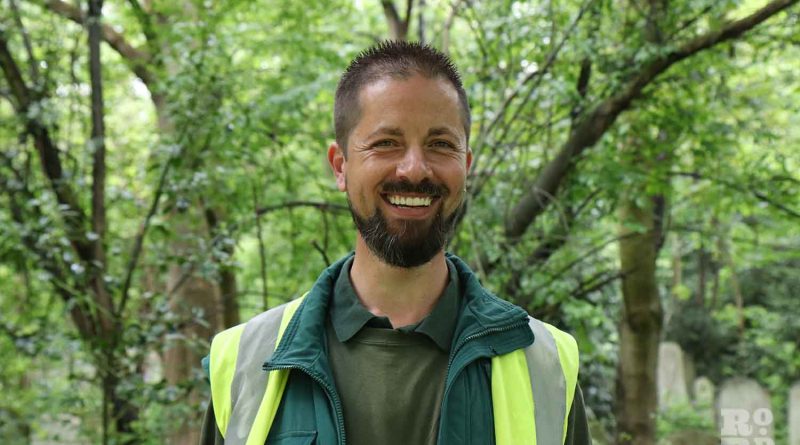Ken Greenway on how to ‘see nature, enjoy it and find comfort in it’
Manager of Tower Hamlets Cemetery Park for 19 years, Ken Greenway, shares his secret on how to make space for nature amidst the densely crowded, take-away coffee-consuming, nature-craving, cigarette-stubbing population of East London.
Strolling with Kenneth Greenway – ‘Ken’ to the regular dog walkers who stop to pick his brains on plant names and uses – is a commuter’s worst nightmare. Every now and then we stop, seemingly at random, for an unspecified period of time, and gaze at the wildflowers sprouting among the gravestones.
Once we restart, Greenway sets a soft, measured pace, agonisingly slow for his companion more used to rushing frenetically between meetings.
A youthful 44-year-old who talks exuberantly, Greenway’s unhurried gait is not down to physical impediment or fatigue. Quite the opposite. He is savouring the ground we tread upon.
Having spent almost 20 years nurturing Tower Hamlets Cemetery Park, his sense of smell is highly developed. As we walk along the paths, he points out not just the sights but the scents of the park: wild garlic, the German waldmeister (akin to freshly mown hay) and elderflower.
Born in Forest Gate, in the neighbouring borough of Newham, Greenway spent his childhood in Romford. At the age of 11 he moved to South Woodham Ferris, in Chelmsford, Essex, where he still lives to this day with his family and, near his mother.
Greenway sees himself as part of the last generation of children who were ‘kicked outside and told to come home at dinner time or when the street lights came on.’
His interest and love for the outdoors failed to wane with age, rather intensified during his teenage years, a time when rainforest deforestation and the greenhouse effect dominated the political climate.
But rather than follow the obvious career path in conservation after studying for an Environmental Biology degree at the University of Greenwich, Greenway realised something that many naturalists don’t.
Plants and animals and wildlife are in themselves glorious, but without human connection to them, the whole endeavour of environmental conservation is futile.
Greenway started at Tower Hamlets Cemetery park aged 25, but when the three years of funding allocated to the role ended, Greenway knew he needed to stay, so The Friends of THCP worked to keep him on.
Nineteen years later, he is still there. In six years time, Greenway will have spent half of his life working to make this one of London’s most loved spaces.
Entering into a clearing, we stop at a large wooden octagon, the sides designed to create inward-facing benches and an arch under which we pass to enter the space. On this spot once stood the Dissenters’ Chapel, demolished in 1972.
For someone who has spent almost 20 years surrounded by gravestones, it is ironic to hear that Greenway is himself a dissenter, or a non-believer, at least. He describes himself as a ‘militant angry atheist,’ though it’s hard to imagine such a gentle presence becoming angry, let alone militant.
Even over-enthusiastic foragers who sometimes plunder the cemetery’s carefully planted wild garlic are asked simply to email for permission first, ‘so we can give them guidance on how to do it in an ethical way’.
So there’ll be no marble tombstone for Kenneth Greenway: ‘You’re born, you’re dead, you don’t know you’re born, you don’t know you’re dead. So when I’m dead it is very much for the living to sort out,’ he describes.
‘A tree with a plaque, maybe’, he concedes, but ideally, he’ll simply ‘kind of sit here under a tree, right here at the park and quietly die, that would be nice.’
As we talk we come to Monument Glade, so-called as it can be found near the Charles Francis Monument. Francis sat on the board of directors of the cemetery in the 1800s and his tomb is the last remaining monument in this clearing.
‘I really like Monument Glade because it’s a nice example of what we try and do in the Cemetery Park,’ Greenway explains, gesturing at the wildflower meadow packed with delicate white cow parsley, bluebells and sticky goosegrass.
While some of the plants may have been part of the original landscape or found their own way into the soil, the majority of ‘new trees and all the wildflowers have been physically planted either as seeds or wildflower plugs or small bare-root trees’ by the Friends of the park.
Such are the efforts of volunteers to maintain the diversity of plants in the park, that over half of Britain’s 59 species of butterflies have been recorded in the park.
Looking down at the path, we see that it has been widened: the effect of an abnormally sunny spring coinciding with the first pandemic lockdown. Around a foot of extra space has been trodden into the side of the path where walkers have made room to social distance or dodge panting joggers.
When Victoria Park closed in March 2020, those craving the outdoors discovered the cemetery park, which led to an ‘unparalleled level of use, it was absolutely crazy.’
‘We do have a “live and let live” attitude here… it is the place where people can be with their family and friends, and drink or smoke or just hang out but,’ he adds,‘we just want people to be mindful that it’s used by others, so just, you know, tone it down a bit if you need to.’
It’s a mantra that’s worked really well for the Friends of THCP, who acknowledges that not everyone has a garden to relax in – for the park to have a purpose, it must be used, enjoyed and loved by all.
While Greenway found it tough to watch the Park being taken over by hoards of (sometimes inconsiderate) visitors, he accepts that ‘this place has no defence against development unless it’s used.
One year of heavy use isn’t the end of the world. Nature is robust, so she’ll cope and she can recover.’
Stopping to pet a passing black labrador – Shadow – we have come to the Forest School, a clearing containing tree stump seats, a mud kitchen, the balancing log and – every child’s fantasy – a climbing tree that transforms into a den tree with the simple addition of some dead branches.
Listening to the chirping birds, Greenway comments ‘I always say the sound of nature is just making baby sounds – nature saying “I want to make babies!’
Greenway has two ‘babies’, of his own. His youngest, Elsie, had her first birthday and naming ceremony here in the park.Amelia, his eldest, is an excellent bug-spotter.
The aspirations Greenway has for his children are not grandiose; ‘I don’t expect them to have a career in nature conservation, but I want them to see nature and enjoy it and find comfort in it.’
Greenway’s knowledge of the Park’s fauna and flora is unsurpassed. However, it’s not knowledge gained for the sake of knowledge, to be recorded in the history books and taught in classrooms. It’s about the feelings of joy that a familiarity with nature evokes.
‘I have this fantasy in my mind that one day one of my daughters will be on a train or a bus, and they’ll look out the window and have that quiet moment of enjoyment – of being able to notice something, recognise it, name it; and the satisfaction that gives you in being able to see the natural world,’ he says.
‘And that’s kind of what I want to leave them – this imprint that nature’s a place to always go back to. It’s never going anywhere and it’ll always be there for you.’
While many conservationists focus on the fragility of a natural world that disintegrates at the human touch, Greenway has great faith in its tenacity. Beautiful flowers are not to be sealed in a perspex box to be admired. They are to be smelt, rolled among, and used to flavour custards.
He believes coexistence between humans and nature is possible, even in the densely crowded, take-away coffee-consuming, nature-craving, cigarette-stubbing population of East London.
But in order for nature’s bounty to be enjoyed in this way, it must not be trampled upon. For Greenway, the secret is simple; live and let live.
If you enjoyed this, you might like our interview with Bow playwright Simon Stephens.


